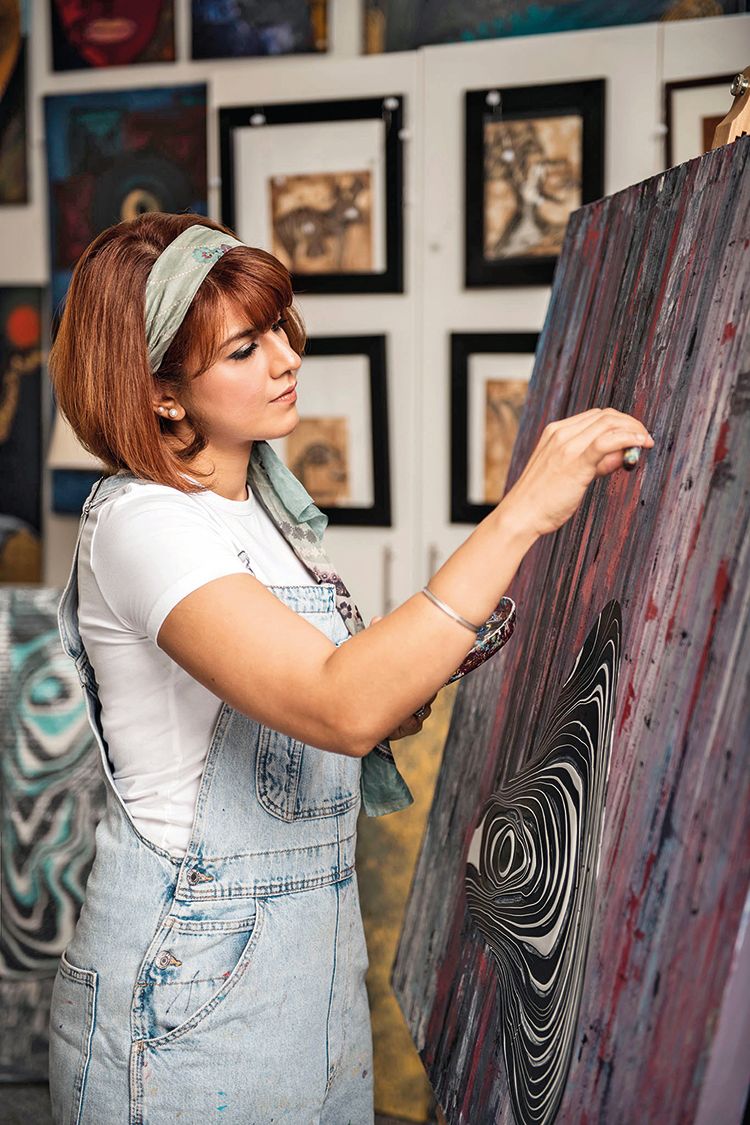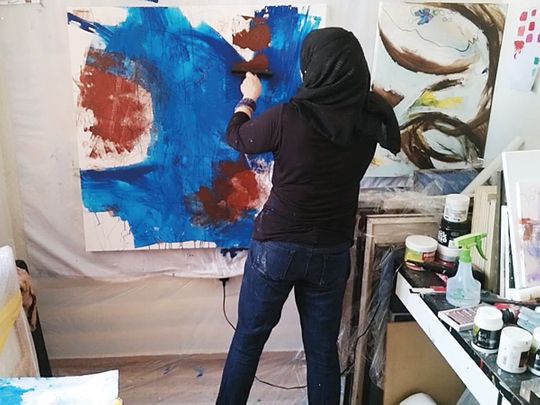Tearing rolls of white paper, Shabnam Habib sticks them on the living room wall of his home in Dubai. She then dips her brush into a pot of paint and engraves a series of symbols on the austere leaves. Moving her whole body with each stroke, she lets herself be guided by her intuition to fill the canvas. Soon, splashes of multicolored paint intertwine with the symbols, superimposed with writing. A few hours later, Shabnam is still lost in the creation of this abstract piece.
She had been doing such art for days and weeks, each time feeling calmer and more resilient as she poured out all the pent-up grief inside her since her husband’s sudden death at the start of the pandemic. Unable to go to her native Pakistan, where her husband had succumbed to an unexpected heart attack, she had braved this loss alone, without even being able to attend his last rites and say a last farewell to him.
“That’s when art became my saviour,” Shabnam shares, “it stabilized my emotions. The whole body movement while creating art released my blocked energies and started the healing process. At first, Shabnam had tried to immerse himself deeply in his work, but the long hours and endless sleepless nights ended up taking a toll on his health. It was only a few months later, when she picked up her brushes to paint, that she found hope and the meaning of life.
Shabnam is one of many people who have benefited from art as therapy. A powerful tool of expression, art is increasingly practiced in the world today. Research suggests that the use of artistic self-expression helps individuals improve their mental and emotional well-being. Art as therapy is gaining momentum at a time when dozens of human beings are grappling with mental and emotional challenges fueled by the pandemic. According to the WHO, in the first year of Covid itself, there was a 25% increase in cases of depression and anxiety worldwide.
Huzefa Goga found art to be the tool that helped her overcome the anxiety caused by the pandemic
Image Credit: Supplied
At the start of the pandemic, Dubai resident Huzefa Goga also found herself in an unpleasant emotional state. Triggered by the fear and uncertainty stoked during the deadly outbreak of Covid virus strains, he experienced severe mood swings. “The pandemic was changing both the outside world and my inside world. I was living life in two extremes – feeling anxious, depressed and angry. It was becoming difficult to function day to day,” he says.
Architect, businessman, and aquascaper, Huzefa had sporadically turned to art earlier, but during this dark phase, when he felt claustrophobic one night, he began sketching inside his home. ‘a square. “It was basically a simple sketch with straight lines and basic colors – I used black to describe my feelings of desperation, white for simplicity and red for intensity. I followed it with several other such sketches, each expressing my inner turmoil. Creating them gave me purpose and I titled the series ‘Man in a Box’,” says Huzefa, who also consulted an art therapist in Dubai. In fact, these sketches played an important role when he was later diagnosed with bipolar disorder.
Doodling, painting, drawing and coloring – any art form helps channel stress, calms the mind and releases emotions, experts say. Engaging in artistic activity especially helps those who have difficulty expressing themselves verbally. For centuries, human beings have used artistic expression to tell stories and document events. The formal practice of art therapy dates back to the mid-20th century, when it was first invented by British artist Adrian Hill in 1942. During this time, thousands of people suffered from tuberculosis and had to live in sanatoria. Drawing and painting have been observed to be a creative outlet for these patients. The practice of art therapy was later adopted by psychiatric hospitals thanks to the initiatives of Edward Adamson, a British artist who observed and studied the links between artistic expression and emotional release.
While the British Association of Art Therapists (BAAT) was founded in 1964, the American Art Therapy Association (AATA) was established in 1969. There are several art therapy and art-therapy associations around the world today. therapists. Although art can be used as therapy for creative engagement and relaxation, art therapy follows a more professional mode of treatment, which has its roots in psychoanalysis. An art therapist uses clinical skills to create an individualized session based on the needs of the patient. Previous research has also supported art therapy as a low-risk way to help people cope with many health issues, including depression, trauma, bipolar disorder, and self-esteem issues. self.

Kim Oberoi found art helped her deal with the many challenges she faced in life
Image Credit: Supplied
Looking back, Dubai-based Indian artist Kim Oberoi recalls that art has always been a constant companion in her life, helping her overcome life’s challenges. Growing up in India, in an emotionally unstable environment and facing bullying at school, she recalls, resorting to her sketchbook to express her feelings. “At the time, I was coming home from school and doing charcoal portraits of wild animals. I noticed that the time I spent making art gave me renewed strength to face the world,” Kim shares.
As an adult, as she changed careers from hotel management to aviation, much against her parents’ wishes, art once again empowered her to stand up for what she believed in. . relationship and later facing the prenatal blues, it was the art that held his hand. “Everything that was going on in me was reflected in my art. Interestingly, it was never the pain and the tears, but rather the hope and the strength that I believe I have inside that was visible on my canvas,” Kim shares. Navigating through these life-changing moments helped her evolve her art. Today, she is a full-time artist and gives lessons for children and adults.
To enjoy the benefits of art as therapy, you don’t need to have exceptional artistic abilities or know specific techniques. It’s the process of creating art that really matters. The goal here is to enjoy what you do. “When I started making art during the low phase of my life, I didn’t care much about aesthetics. I was detached from the outcome of what I was creating on my canvas. I wasn’t doing of art for an audience, it was for myself,” says Shabnam. Coincidentally, artistic intervention in Shabnam’s life eventually helped her steer a new career. She quit her corporate job and is now an abstract expressionist artist.
While seeking solace and healing through art, Huzefa also discovered a new talent within himself and received wide recognition among his peers. He has now completed over a hundred sketches in the Man in a Box series, exhibiting them at World Art Dubai and the International Studio of Art and Galleries, Dubai. The series is also expected to be published in a book later this year. “Art has helped me see the world in a different way, helping me overcome most of my personal challenges today,” he says.
LEARN MORE ABOUT ART THERAPY
Najah Musthafa works as an Art Psychotherapist at ATIC Psychology and Counseling Center in Dubai.
What is art therapy? How is it different from art as therapy?
Artistic creation is a universal enterprise that we explore for pleasure and healing. The restorative properties of art are varied and vast. It is therefore not surprising that many of us use it for its therapeutic benefits. However, art as therapy and art therapy are not the same.
Art therapy is an evidence-based, experiential psychotherapy approach that uses creative, innovative, hands-on, hands-on techniques with a licensed therapist. It integrates mental health and human services using active artistic creation, the creative process, applied psychological theory and human experience. Art therapy is eclectic as it incorporates a range of different theoretical frameworks and approaches. It is a process safely guided by licensed professionals trained in both psychology and art.
What happens during an art therapy session?
Art therapy can include a wide range of artistic materials and processes. The structure and choice within a session is individualized. There is often an art-making component including activities such as drawing, clay work, painting, sandboxing, collage and the use of natural objects.
Who benefits from art therapy?
This holistic approach offers people facing physical, emotional and cognitive challenges new pathways to self-understanding and self-expression. Art therapy is for people of all ages and backgrounds. It is inclusive for people at different stages of development and even for determined people.


